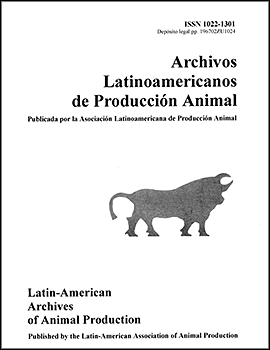
|
Archivos Latinoamericanos de Produccion Animal
Asociacion Latinoamericana de Produccion Animal
ISSN: 1022-1301
EISSN: 1022-1301
Vol. 13, No. 1, 2005, pp. 24-29
|
 Bioline Code: la05004
Bioline Code: la05004
Full paper language: Portuguese
Document type: Research Article
Document available free of charge
|
|
|
Archivos Latinoamericanos de Produccion Animal, Vol. 13, No. 1, 2005, pp. 24-29
| en |
Use of segmented polynomials to study the lactation curve of Murrah and their crossed breeds of buffaloes under an extensive production system in the State of São Paulo
M. Muñoz-Berrocal, H. Tonhati, M.F.Cerón-Muñoz, L.O. Seno, A.R. Otaviano
Abstract
The objective of this study was to evaluate the use of segmented polynomials, described by the two models quadratic-quadratic (PSQQ) and that with three quadratic segments (PSQQQ), for adjustment of the mean lactation curve of Murrah females and their crosses under a system of extensive production, with once daily milking. Studies of this nature in buffaloes are practically non-existent. Milk production data from twelve herds, including 1280 lactations and 8839 test-day milk weights were analyzed. Test days were spaced at 30-day intervals, during the period from 1995 to 2001. Lactations included in the analysis were based on a minimum of four and a maximum of nine test days. For the PSQQ model, the mean curve reached its «Knot» (junction point between the segments) in the second month of lactation, while for the PSQQ model the «Knots» were estimated to be in the second and fourth months. The parameters of each function were estimated by interactive procedures, using PROC REG of SAS. Criteria used to verify the goodness of fit for each function were: adjusted coefficient of determination (R2A); lack of fit test (LOF); and graphic distribution of residuals and of residual lag. The two models closely described variations in milk production throughout the lactation with the lack of fit tests not significant. The coefficients of determination were practically identical for both models under study (R2A = 91.3%).
Keywords
Buffaloes, Lactation curves, Mathematical functions, Segmented polynomials.
|
| |
| pt |
Uso de polinômios segmentados para o estudo da curva de lactação em Búfalos Murrah e seus mestiços en sistema de criação extensivo, no Estado de São Paulo
M. Muñoz-Berrocal, H. Tonhati, M.F.Cerón-Muñoz, L.O. Seno, A.R. Otaviano
Resumo
O objetivo deste estudo foi avaliar o uso de Polinômios Segmentados, dados pelos modelos Quadrático-Quadrático (PSQQ) e com três segmentos quadráticos (PSQQQ), no ajuste da curva de lactação média de animais Murrah e seus mestiços sobre um sistema de criação extensiva com uma ordenha por dia. Estudos desta natureza com búfalos praticamente não existem. Trabalhou-se com doze rebanhos, utilizandose 1280 lactações, referentes a 8839 controles de produção de leite. O controle leiteiro foi feito em intervalos de 30 dias, no período de 1995 a 2001. As lactações utilizadas continham no mínimo quatro, e no máximo nove controles. Para o PSQQ, a curva média alcançou o «Nó» ponto de junção entre os segmentos no 2° mês da lactação, já para o PSQQQ os «Nós» foram estimados para o 2° e 4° mês da lactação. Os parâmetros de cada função foram estimados por processos iterativos, usando-se o PROC REG do SAS. Os critérios utilizados para verificar a qualidade do ajuste para cada função foram: Coeficiente de Determinação Ajustado (R2A), Teste de Lack of Fit (LOF), gráficos de distribuição de resíduos e o gráfico de Lag de resíduos. Os PSQQ e PSQQQ, acompanharam as variações na produção de leite ao longo da lactação, sendo não significativos os testes de Lack of Fit. Os coeficientes de determinação praticamente foram idênticos para os modelos em estudo (R2A=91,3%).
Palavras-chave
Búfalos, Curva de lactação, Funções matemáticas, Polinômios segmentados.
|
| |
© © 2005 - ALPA. Arch. Latinoam. Prod. Anim.
Alternative site location: http://www.alpa.org.ve/ojs/index.php
|
|
